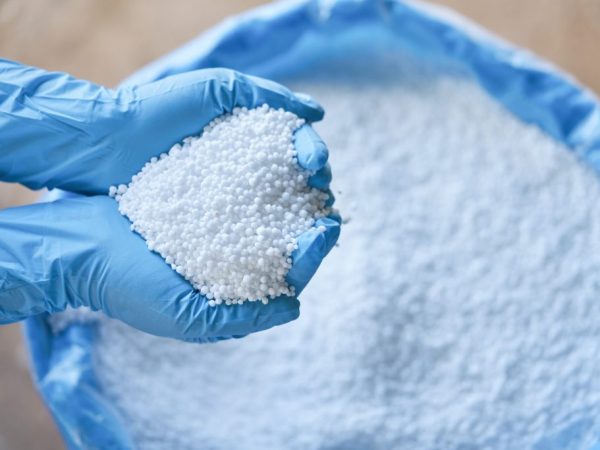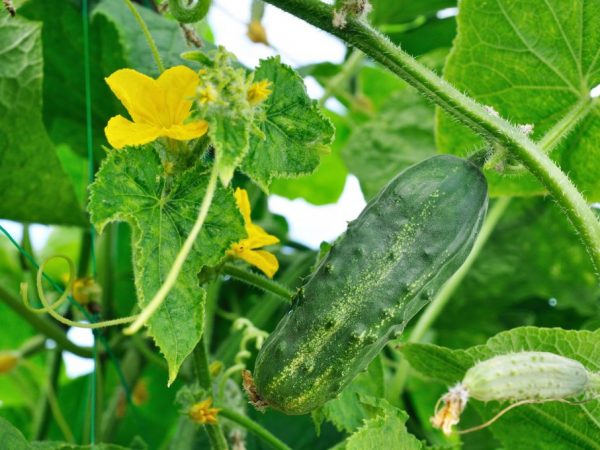How to feed cucumbers with calcium nitrate
Cucumbers are very responsive to organic and inorganic fertilizers. Feeding cucumbers with saltpeter is one of the most common ways to meet the plant's nutrient needs.

Feeding cucumbers with calcium nitrate
However, nitrate salts are different: potassium, ammonia, calcium. Each of the fertilizers has its own indications for use and characteristics of the impact on crops.
Fertilizer characteristic
Calcium nitrate is a nitrogen-containing inorganic salt, which is white crystals or granules, readily soluble in water. Other names are calcium nitrate, calcium nitrate, calcined nitrate. The substance is very hygroscopic, therefore it is sold in a sealed package. The nitrogen content in salt is 13%, calcium is 19%. Crystalline powder is very dusty when poured and absorbs water faster, in contrast to the granular form.
Fertilizer is less popular among vegetable growers than other inorganic, due to the fact that, according to the general idea, calcium is not so much in demand by plants than potassium or phosphorus. However, it is the presence of calcium that contributes to a more complete assimilation of nitrogen by plants, which is so necessary at the initial stages of the growing season.
Application features
Cucumbers are a crop dependent on soil quality. The root system is not strong enough, the plant has a relatively short growing season. The quantity of the crop and its quality depend on the timely supply of nitrogen, phosphorus and potassium. Ammonium nitrate is a good source of nitrogen, but its accumulation in fruits can harm human health.
Many gardeners believe that calcium nitrate is the best alternative. The use of fertilizer gives many positive consequences, since the substances that make up its composition are actively involved in the metabolic processes of the plant. In this case, nitrates do not accumulate.
What result can be obtained when adding calcium nitrate for feeding cucumbers:
- promotes the formation of cell membranes, improves photosynthesis, and as a result, the growth of green mass;
- stimulates root formation, prevents harmful effects on the root system of bacteria and fungi, increases immunity;
- helps the plant to tolerate temperature changes without loss;
- provides an increase in yield by at least 15%.
Calcium nitrate can be used to fertilize any type of soil. It is especially suitable for acidified people, since it does not cause acidity increase, unlike ammonium nitrate. It manifests itself most effectively on sod-podzolic soils.
How to use
Fertilizer is applied to the soil before the spring digging. It is not recommended to fertilize in autumn, because in spring, nitrogen will be washed out of the soil, and without it calcium is not effective.
Top dressing can be done:
- before planting cucumbers: a teaspoon of fertilizer is applied directly into the hole, mixed with the ground (so that the roots do not burn); if poured under the seeds, they stimulate germination;
- during the growing season after irrigation with an aqueous solution under the root every 10-14 days (25 g per 10-15 liters of water);
- foliar method; spraying the solution on the leaves helps to increase the immunity of plants, prevents the defeat of putrefactive bacteria.
For foliar feeding, use a solution prepared from 2 g of fertilizer per 1 liter of water. The first treatment is carried out after the appearance of 3-4 true leaves, then it can be repeated every 10 days, until the beginning of fruiting.

It is important to properly prepare the fertilizer solution.
Top dressing can be carried out according to indications. If the leaves turn pale, decrease in size, it means that the plant is deficient in nitrogen. It is important to observe the recommended concentration, otherwise, instead of benefit, you can harm the root system or leaves (depending on the method of application).
How to make calcium nitrate
Calcium nitrate is sold in specialized stores. Its price is usually slightly higher than traditional ammonium nitrate, but the effect is worth it. If necessary, you can prepare the fertilizer yourself. The process of cooking calcium nitrate is accompanied by the release of a specific smell, so the procedure should be carried out in a ventilated place, preferably in the open air. Be sure to use personal protective equipment - rubber gloves and a respirator.
The initial components are slaked lime and ammonium nitrate. Bring an aqueous solution of ammonium nitrate to a boil over high heat in a saucepan. Proportions: 3 parts salt - 5 parts water. After boiling, lime is introduced in small portions, stirring constantly. For 1 liter of water - 280 g of lime. The cooking process lasts 35-40 minutes. As soon as the ammonia smell has ceased to stand out, the procedure can be considered complete. Fertilizer is ready.
In the pan, a dark lime precipitate falls out and a liquid is formed - calcium nitrate. It is diluted in water and used for root and foliar feeding.
Fertilization of garden and horticultural crops
A good result is shown not only by the tandem: cucumbers and calcium nitrate. Responsive to calcium nitrate and other garden and horticultural crops. Fertilizer is successfully used for application under cabbage. The vegetable does not like acidic soils, therefore, applying at the root and processing the head of cabbage with this substance give an excellent result.
Processing tomatoes on the leaf prevents the appearance of top rot, which significantly reduces crop yields.
Fertilization of flower plants is recommended: petunias, phloxes, lilies. Calcium nitrate is an excellent defender against rot and helps to withstand adverse weather conditions. For processing, a solution is prepared: 1 teaspoon of the substance per 1 liter of water.
In early spring, fertilizer is applied under berries and fruit trees (25 g per 10-15 liters of water).
Conclusion
Calcium nitrate contributes to the formation of a nutrient medium, stimulates the growth and development of plants, improves the quality of the crop, preventing the spread of diseases.
Experts believe that fertilizing with calcium nitrate is possible and necessary in any climatic zone, but the greatest effect of application is observed in regions with an arid climate.


